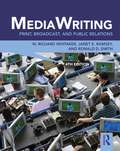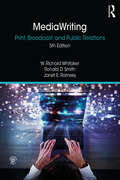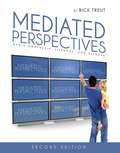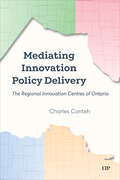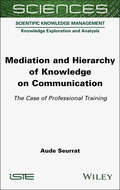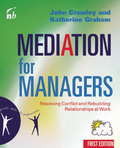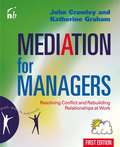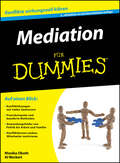- Table View
- List View
Media: Watchdog or Lapdog?--Marketing, Politics, and the Media
by John A. Quelch Katherine A. JoczIs the modern media industry living up to its role as a bulwark of democracy and guardian of the public interest? Private-sector media does democratize access to news and information via a proliferation of outlets and products. However, consumer demand for hard news is declining and many display rising dissatisfaction with the media's political coverage. Ultimately, the fate of media depends both on its status as a public good and on market forces.
MediaTek: From Feature Phones to Smartphones
by Willy ShihMediaTek was the third largest fabless semiconductor company in the world, and was the second largest supplier of the silicon microchips that powered mobile phones. Yet as the company's chairman reflected on his R&D strategy, he wondered why it hadn't moved faster on the transition to smartphones. He also thought about what was on his firm's menu of choices, and what was on the menus of his competitors.
MediaTek: From Feature Phones to Smartphones
by Willy ShihMediaTek was the third largest fabless semiconductor company in the world, and was the second largest supplier of the silicon microchips that powered mobile phones. Yet as the company's chairman reflected on his R&D strategy, he wondered why it hadn't moved faster on the transition to smartphones. He also thought about what was on his firm's menu of choices, and what was on the menus of his competitors.
MediaWriting: Print, Broadcast, Online, and Public Relations
by Ronald D. Smith Janet E. Ramsey W. Richard Whitaker Deborah A. Silverman Brian S. Meyer Joe MarrenAccessible and engaging, this book is an invaluable resource for students planning to enter the dynamic and changing world of media writing.Drawing on a wealth of real-world examples and featuring helpful "How To" boxes throughout, MediaWriting explains the various styles of writing for print, broadcast, online, social media, public relations, and multimedia outlets.Expanded and updated throughout, this sixth edition features: A look at how journalists and PR practitioners use and write for social media platforms such as X and Facebook; Tips for better web writing, research, interviewing, and headline writing across multiple media platforms, including covering breaking news in the digital world; Coverage of public relations writing for digital media, publications, and other organizational media; Updates on current ethical issues faced by communicators; Information on spotting “fake news” and “deep fakes”; Strategies for integrating sound bites into broadcast scripts; New “It Happened to Me” anecdotes from the authors’ experiences as journalists and PR professionals; Updated discussion questions and writing exercises. Designed to meet the needs of students of digital, print, and broadcast media, public relations, or a wannabe jack-of-all trades in the online media environment, this reader-friendly primer will equip beginners with all the skills necessary to succeed in their chosen writing field.Online instructor and student support material is available for this book, including sample syllabi, quizzes and answer keys, chapter overviews, and links to further resources.
MediaWriting: Print, Broadcast, and Public Relations
by Ronald D. Smith Janet E. Ramsey W. Richard WhitakerMediaWriting is an introductory, hands-on textbook for students preparing to write in the current multimedia environment. Rather than just talk about the differences among the styles of print, broadcast, and public relations, MediaWriting sythensizes and integrates them, while weaving in basic principles of Internet writing and social media reporting. Complete with real-world examples, practical writing exercises, and tips and information for entering into the profession, MediaWriting continues to give students the tools they need to become a successful media writer. The new edition has been extensively rewritten to reflect the dynamic nature of the profession, paying significant attention to how the Internet and social media have become essential communication tools for print and broadcast journalists, and public relations professionals. Further updates and features include: Increased attention to computer-assisted reporting, the preparation of online copy, and social media applications Two new chapters on lead writing and new new media A separate chapter focused solely on ethics Explanatory "how to" boxes that help students understand and retain main themes Illustrative "It Happened to Me" vignettes from the authors’ professional experiences Discussion questions and exercises at the end of every chapter Suggested readings that highlight biographies, books, and websites that expand the scope and definition of professionalism In addition to new multimedia elements, the fourth edition’s companion website features enhanced resources for both students and instructors, including chapter overviews, writing tips, a test bank, sample critiques, and a sample syllabus.
MediaWriting: Print, Broadcast, and Public Relations
by Ronald D. Smith Janet E. Ramsey W. Richard WhitakerMediaWriting is an invaluable resource for students planning to enter the dynamic and changing world of media writing in the twenty-first century. With easy-to-read chapters, a wealth of updated, real-world examples, and helpful "How To" boxes throughout, this textbook explains the various styles of writing for print, broadcast, online, social media, public relations, and multimedia outlets. Some of the features included in the book are: A re-written Chapter 13, Writing and Reporting in the New New Media, with updates to how social media is used today Expanded chapters on print reporting methods and the Associated Press Stylebook Updates to Chapters 5 and 6, Legal Considerations in Media Writing, and Ethical Decisions in Writing and Reporting, discuss recent court cases and current ethical issues Explanatory "How To" boxes that help readers understand and retain main themes Illustrative "It Happened to Me" vignettes from the authors’ professional experiences Discussion questions and exercises at the end of every chapter Designed to meet the needs of students of print and broadcast media, public relations, or a wannabe jack-of-all trades in the online media environment, this reader-friendly primer will equip beginners with the skills necessary to succeed in their chosen writing field.
Mediated Citizenship
by Bettina Von Lieres Laurence PiperDrawing on case studies from the global South, this book explores the politics of mediated citizenship in which citizens are represented to the state through third party intermediaries. The studies show that mediation is both widely practiced and multi-directional and that it has an important role to play in deepening democracy in the global South.
Mediated Perspectives: Media Ownership, Literacy, and Effects
by Bick TreutThis anthology focuses on the history of the media from a media ecology perspective. It encourages students to think about the media system, not merely as a source of entertainment, but as a business designed to target viewers and sell products.
Mediating Innovation Policy Delivery: The Regional Innovation Centres of Ontario
by Charles ContehReport cards and academic scholarship have been critical of innovation policy in Canada. But what if these reports have done a profound injustice to the story of knowledge-driven economic reinvention and the actual transformation taking place in the country? Spotlighting what is happening in cities and regions across Ontario, Mediating Innovation Policy Delivery argues that it is far more nuanced and exciting than what has been captured in scorecards and report cards. The book explores the intermediary institutions, the organizational brokers at the frontline of Canada’s innovation race, that are shepherding the process of economic reinvention in regions large and small. The book draws on case studies to explore three central themes. The first is about innovation, innovation policy, and their delivery systems. The second is that of regions as the frontlines of technological and socioeconomic change in the Canadian federation. The third covers the role of intermediary institutions as innovation platforms, highlighting their triumphs and tribulations as they strategically navigate through the shifting currents of change. The book’s main lessons apply not just to Ontario and Canada but also to other industrialized democracies worldwide. Ultimately, the book advances our knowledge of organizational instruments of innovation policy delivery that operate at the strategic interface between the state, market, and society.
Mediating Role of Social Media on Youth’s Psychological Well-Being: A Machine-Generated Literature Overview
by Ashwini KothambikarThis book is the result of a collaboration between a human editor and an artificial intelligence algorithm to create a machine-generated literature overview of research articles analyzing the mediating role of social media on the psychological wellbeing of youth. It’s a new publication format in which state-of-the-art computer algorithms are applied to select the most relevant articles published in Springer Nature journals and create machine-generated literature reviews by arranging the selected articles in a topical order and creating short summaries of these articles. In this volume, a human counsellor psychologist used the algorithm to explore articles that present results of research about the impacts of social media on the psychological wellbeing of youth. The Internet has always been popular among youth, but during the pandemic it has attracted even more attention since many aspects of life further migrated to the digital world, thus adding substantially to Internet’s ever-increasing popularity. Today, youth spend a majority portion of their time on the Internet and an increasing amount on social media. In such digitally dependent times, this book attempts to provide insights on the positive and negative impact of the Internet and social media on youth mental health, and also provides specific observations on personality traits.
Mediating Sovereign Debt Disputes (European Yearbook of International Economic Law #35)
by Calliope Makedon SudboroughThis book provides a fresh perspective on resolving sovereign debt disputes within the investor-state mediation framework. In response to the limitations of traditional approaches to adjudicating public debt issues and the resulting gaps in international law concerning sovereign defaults, creditors have increasingly turned to investor-state treaty arbitrations to recover unpaid debts. However, this shift has raised numerous criticisms and concerns.Accordingly, this book explores the uncharted territory of utilizing mediation as a means to settle sovereign debt claims. It sheds light on the distinctive characteristics of mediation as a process, setting it apart from judicial litigation and private arbitration, and emphasizing the unique outcomes it can generate. The central argument of this book is that mediation should be seriously considered as a viable option for resolving sovereign debt disputes. Not only does it offer a more cost-effective and expeditious approach, but it also has the potential to facilitate economic recovery and sustain continued investment.
Mediating Sustainability in the Consumer Society (Routledge Studies in Sustainability)
by Dagny Stuedahl Astrid Skjerven Lisbeth Løvbak Berg Liv Merete NielsenThis book sheds light on the role and impact of sustainability mediation, an effective tool for political authorities and business enterprises to persuade consumers of the integrity of their actions, products, and services.In this era of ecological and societal crises fuelled by increasing consumption, sustainability has become a key buzzword and target to attain. Governments around the world argue that they will meet their sustainability goals through environmental actions, by enabling consumers to make better choices and expecting brands to respond accordingly. At the same time, consumers are overwhelmed by the messaging conveyed in sustainability marketing campaigns, often featuring misleading greenwashing, with political authorities, organisations, and business enterprises all having conflicting interests. In this complex scenario, mediation has become a crucial issue. This book offers a critical and multidisciplinary view of sustainability mediation from experts in the fields of philosophy, consumption research, media studies, fashion, design, and citizenship, offering a unique, holistic view. Each chapter highlights different and problematic aspects of the cultural narratives being communicated, for example, the necessity of growth and the notion of a green economy. They present current theories, methods, indicators, and strategies used to assess and measure the relation between mediation, behaviour, and sustainable development.This book is of interest to scholars, researchers, and postgraduate students in all subject fields concerned with sustainability, including design, visual communication, fashion, consumption, media and journalism, and sustainable development.
Mediating the Global: Expatria's Forms and Consequences in Kathmandu
by Heather HindmanTransnational business people, international aid workers, and diplomats are all actors on the international stage working for organizations and groups often scrutinized by the public eye. But the very lives of these global middlemen and women are relatively unstudied. "Mediating the Global" takes up the challenge, uncovering the day-to-day experiences of elite foreign workers and their families living in Nepal, and the policies and practices that determine their daily lives. In this book, Heather Hindman calls for a consideration of the complex role that global middlemen and women play, not merely in implementing policies, but as objects of policy. Examining the lives of expatriate professionals working in Kathmandu, Nepal and the families that accompany them, Hindman unveils intimate stories of the everyday life of global mediators. "Mediating the Global" focuses on expatriate employees and families who are affiliated with international development bodies, multinational corporations, and the foreign service of various countries. The author investigates the life of expatriates while they visit recreational clubs and international schools and also examines how the practices of international human resources management, cross-cultural communication, and promotion of flexible careers are transforming the world of elite overseas workers.
Mediation Law: Journey through Institutionalism to Juridification
by Penny BrookerIn England mediation became a key part of the civil justice reform agenda after the Woolf Reforms of 1996, as disputants were deflected from litigation towards settlement outside the court system. The Civil Procedure Rules (CPR) give courts the power to ‘encourage’ mediation through judicial case management or use stronger measures by using costs to penalise parties who act unreasonably by refusing to use ADR or mediation. One of the effects of this institutionalisation is an emerging case law that defines how mediation is practiced as it is merges with the litigation process. When mediation first began to be used in England the parties either agreed to mediate by a contract before a dispute happened or decided to attempt the process as a way of resolving disagreements. Inevitably, some disputants either refused to abide by their contractual obligations or would not follow through with the settlement agreements reached through the process. This brought the authority of the law into a new area and the juridification process began. This book explores how mediation law shapes the practice of mediation in the English jurisdiction. It provides a comprehensive examination of the legal framework for mediation, and explores the jurisprudence in order to analyse the extent that institutionalisation by the state and courts has led to the monopolisation by lawyers and a further ‘juridification’ process results. The book includes a comparative legal methodology on the framework underpinning mediation practise in other common law jurisdictions, including the United States, Australia, and Hong Kong, in order to explicate shared or distinctive approaches to mediation. The book will be of great interest to academics and students of legal theory and dispute resolution.
Mediation and Hierarchy of Knowledge on Communication: The Case of Professional Training (ISTE Consignment)
by Aude SeurratThis book explores the various forms of knowledge selection and mediation concerning communication in organizations, particularly focusing on professional communication training courses. The work is based on a corpus study of training catalogues, an interview survey of trainers, as well as ethnographic observations of professional communication training courses. Mediation and Hierarchy of Knowledge on Communication analyzes how the pursuit of certainty contributes to favoring certain types of 'learned' knowledge over others. This analysis reveals that the theoretical frameworks employed in vocational training for communicators predominantly rely on experimental reasoning and explanatory models, drawing upon insights from psychosocial experiments, neuroscience and management science. This quest for certainty has positioned the life sciences as the benchmark for scientific validity, resulting in a form of biologization of communication that this book aims to deconstruct.
Mediation and Transdisciplinarity: Navigating Conflicts in Times of Crisis (Transdisciplinary Management of Ecological and Social Crises)
by Hubert LandierThe world is in crisis at every level: the planet, humanity, and all kinds of human communities, including working communities. The result is likely to be violence and chaos. And yet, man lives and can only live with others. Relationships in all their forms therefore need to be developed with a view to building a common future. However, when this in-between has been broken, when it is no longer possible to get along, when violence threatens or develops in a sometimes dramatic way, it may be necessary for both sides to call on an external third party. This book is based on decades of professional experience in the practice of corporate mediation. It examines the crucial role of mediators in resolving conflicts and fostering understanding in various contexts. By exploring real-life case studies and theoretical frameworks, the book offers valuable insights into how mediation can be a powerful tool for creating a harmonious and sustainable future.
Mediation der Zukunft für Paare und Familien (essentials)
by Thomas SpörerDer status quo der Mediation in Deutschland charakterisiert einen Zustand, der dieser Konfliktbearbeitungsform, gemessen am Bedarf, immer noch eine marginale Rolle zuschreibt. Die Gegenüberstellung einer juristischen Bearbeitung und ihrem non-juristischen Gegenpart unterstreicht zwar die Differenzen in der Vorgehensweise, blendet aber eine vorherrschende Gemeinsamkeit der beiden Systeme aus, die erst deutlich wird, wenn die Sicht darauf aus dem Blickwinkel der Betroffenen fällt. Dieser Beitrag betrachtet speziell Mediation aus der Bedürfnislage der Klientel heraus und fragt danach, wie sich diese Methode verändern muss, wenn sie den Bedürfnissen ihre Betroffenen gerecht werden möchte.
Mediation durch Einzelcoaching für Paare und Familien (essentials)
by Thomas SpörerEin Lehrsatz der Familienmediation betont die Fähigkeit des Individuums zu einer Lösungsfindung bezügl. der eigenen Angelegenheiten. Diese setzen sich zusammen aus eigenen Erfahrungen, Einschätzungen, Hoffnungen, Befürchtungen wie auch zukünftigen Aussichten. Subjektive Bedürfnisse sind somit in Einzelgesprächen bestmöglich recherchierbar und bearbeitbar. Von daher braucht Mediation außer dem Dreiergespräch speziell auch Elemente des Einzelcoachings zur Erarbeitung von einigungsrelevanten Gesprächsanteilen. Dieser Band unterstreicht die Bedeutung von Coachingelementen in der Mediation und beleuchtet außerdem die Zukunftsgestaltung als integralen Bestandteil der Mediationsarbeit über das rechtswirksame Scheidungsurteil hinaus.
Mediation for Managers
by Katherine Graham John CrawleyMediating managers can often deal with different demands, personalities, and behaviors. Discover how to set a positive example on a professional and personal level with Mediation for Managers. Readers will learn to eliminate the stress, illness, and staff losses than can result from conflict, and extract positive results from managed conflicts.
Mediation for Managers: Resolving Conflict and Rebuilding Relationships at Work
by Katherine Graham John CrawleyIn recent years mediation has become an increasingly popular approach and powerful technique and has been used successfully in such areas as commercial disputes and customer complaints-handling. Here, for the first time, is an accessible and practical book on mediation at work and in the workplace itself. Packed with real-life examples and cases, it focuses on mediation's positive way of looking at conflict, how it injects a new dimension into people's "conflict zone", and outlines the qualities needed to be a mediating manager. Mediating managers become beacons of positive energy perceived as people capable of holding things together when others are "losing it". They are able to do this because they are enablers, not judge and jury, catalysts not fixers, encouragers not enforcers. Mapping out the overall steps of the mediation process, what mediating managers' core tasks are at each stage, the opportunities offered to those involved, and illustrating different key moments of effectively resolved workplace disputes, the book demonstrates how transferable mediation skills are and how they can be used in a wide range of workplace settings.
Mediation for Managers: Resolving Conflict and Rebuilding Relationships at Work
by Katherine Graham John CrawleyIn recent years mediation has become an increasingly popular approach and powerful technique and has been used successfully in such areas as commercial disputes and customer complaints-handling. Here, for the first time, is an accessible and practical book on mediation at work and in the workplace itself. Packed with real-life examples and cases, it focuses on mediation's positive way of looking at conflict, how it injects a new dimension into people's "conflict zone", and outlines the qualities needed to be a mediating manager. Mediating managers become beacons of positive energy perceived as people capable of holding things together when others are "losing it". They are able to do this because they are enablers, not judge and jury, catalysts not fixers, encouragers not enforcers. Mapping out the overall steps of the mediation process, what mediating managers' core tasks are at each stage, the opportunities offered to those involved, and illustrating different key moments of effectively resolved workplace disputes, the book demonstrates how transferable mediation skills are and how they can be used in a wide range of workplace settings.
Mediation für Dummies (Für Dummies)
by Al Weckert Monika ObothGibt es in Ihrem Leben Konflikte - beruflich oder privat -, die Sie gern lösen würden, ohne gleich einen Anwalt zu konsultieren oder gar einen Prozess anzustrengen? Dann ist dieses Buch genau das richtige für Sie. Monika Oboth und Al Weckert informieren anhand von vielen Fallbeispielen über die Einsatzmöglichkeiten, Inhalte und Methoden von Mediation als Mittel zur außergerichtlichen Konfliktklärung. Ob bei Trennung, Scheidung oder Erbstreitigkeiten, bei Konflikten in der Schule oder im Beruf oder bei Streitigkeiten zwischen Vertragspartnern - dieses unbürokratische Verfahren ermöglicht es Konfliktparteien, selbst ihre Lösung zu finden. Die Autoren beschreiben die fünf Phasen der Mediation, die Gesprächstechniken und Frageformen, den Umgang mit Gefühlen sowie Eskalationen und zeigen, wie durch Gewaltfreie Kommunikation Verständigung erreicht werden kann. So erfahren Sie, was Sie bei einer Mediation erwartet. Für all jene, die sich als Mediator zusätzlich qualifizieren wollen - Lehrer, Sozialpädagogen, Therapeuten, Personalentwickler oder Juristen - beschreiben die Autoren das Profil und das Handwerkszeug von Mediatoren.
Mediation mit Stellvertretung und Gewaltfreie Kommunikation: Von den Möglichkeiten des Miteinander (essentials)
by Christa Kolodej Susanne ErtlDas Konzept der Mediation mit Stellvertretung wird mittels theoretischer Inputs, praktischer Übungen und Fallbeispielen vorgestellt. Oft wünschen sich Konfliktbeteiligte eine direkte gemeinsame Konfliktregelung, das ist aber nicht immer möglich. Die stellvertretende Rollenübernahme der abwesenden Partei durch eine/einen Mediator*in mittels der repräsentierenden Wahrnehmung eröffnet hier neue Möglichkeiten, die weit über das Feld der Mediation hinausgehen.
Mediation. Design und Setting: Ablauf und Gestaltungsvarianten des Mediationsverfahrens
by Stephan ProkschWas geschieht vor Beginn der Mediation? Wie werden die Parteien zu einander positioniert? Wie gestalte ich einen Klärungsprozess in einer Gruppe? Viel wurde bereits über Gesprächsführung und Technik der Mediation geschrieben. Dieses Buch richtet den Fokus auf einen anderen wesentlichen Aspekt des Prozesses: Den Ablauf vom Erstkontakt bis zur Nachbesprechung sowie das Setting, also die räumliche und zeitliche Gestaltung des Mediationsprozesses in seinen vielfältigen Varianten. Stephan Proksch stellt den Ablauf sowie unterschiedliche Settings anhand von Beispielen aus der Praxis anschaulich dar und widmet sich unter anderem auch der Online-Mediation. Ein hervorragendes Buch für Anwender und fortgeschrittene Studierende der Mediation.
Mediation: A Concept for Information and Communication Sciences
by Jacqueline DeschampsMediation is a very old practice that has been reborn to meet the needs of the contemporary world. It is thus increasingly present in today's societies. This book presents the theoretical foundations of mediation, as well as the way in which teachers and researchers in Information and Communication Sciences (ICS) have taken up this concept. Whether it is communicational, informational, cultural, organizational or societal, mediation belongs to a field of research, instituted by ICS, which sees in it a process of overcoming conflict, restoring communication and deconstructing social connections. Mediation: A Concept for Information and Communication Sciences inaugurates this set through its contribution to a state of the art of the theory and concepts used by the ICS community. It is addressed to teachers, researchers and students, as well as information professionals wishing to think about their daily practice.


